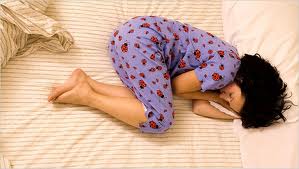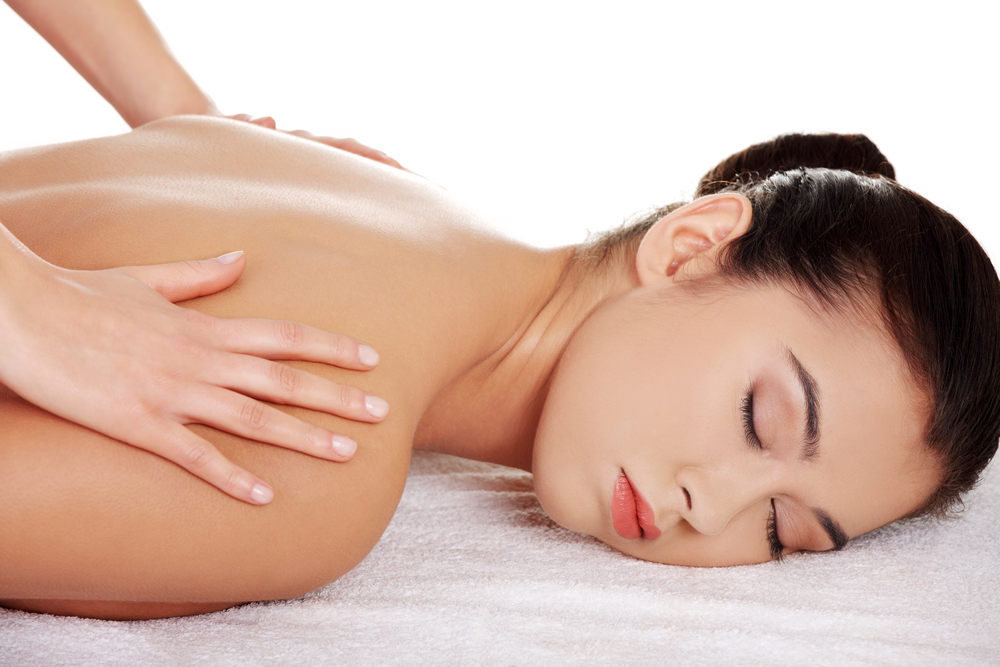

It should not surprise any woman that 9 out of every 10 of us have had Premenstrual Syndrome (PMS) symptoms which may include: aches, pains, emotional stress, abdominal bloating, acne, anxiety, backache, breast swelling and tenderness, cramps, depression, intense food cravings, dizzy or fainting spells, fatigue, headaches, nausea, insomnia, altered sex drive, swelling of the fingers and ankles, and personality changes such as drastic mood swings, outbursts of anger, violence and sadness (yes, an extensive and exhaustive list)!
But keep your chin up ladies and walk away from those donut holes and fried onion rings! There are many great natural ways to beat the PMS blues; including changing the foods we eat. From a nutrition standpoint, the foods we consume, and (on a greater holistic scale) our general lifestyles have tremendous effects on whether or not women experience those monthly symptoms and the severity, as well.
Researchers recently analyzed the diets of over 1,000 women who suffered from PMS and compared their diets to the diets of women who were PMS-free. The following is a list of all the vitamins, minerals and top sources of foods that will turn your PMS day into one that is filled with LOL!
More research is needed to confirm the link. Some researchers have concluded that vitamins B1 and B2 could somehow increase two brain neurotransmitters -- serotonin and dopamine, and a lack of these two neurotransmitters could exacerbate PMS symptoms. What is even better to know, is that people who ate two times the recommended daily value of B1- and B2-rich foods (not supplements), cut their PMS symptoms by 25-35 %! Vitamin B6 helps the body make dopamine (a neurotransmitter), and may reduce irritability, depression and breast tenderness. High intakes of thiamin (vitamin B1) and riboflavin (vitamin B2) -- both found in spinach -- appeared to reduce the risk of PMS symptoms by up to 35 percent.
Top sources of vitamin B include beef, halibut, sardines, eggs, dairy products, chickpeas, turkey, and chicken. Some vegetarian sources of B include bananas, potatoes, sunflower seeds, spinach, tempeh, lentils, some whole grains, chili peppers, green vegetables.
Depending on age and lifestyle, the following are the recommended dietary allowance, or RDA, for B Vitamins. The RDA of B-12 for infants under 12 months is 0.4 to 0.5 micrograms, or mcg. The RDA for ages 1 to 3 is 0.9mcg and 1.2mcg for ages 4 to 8. The RDA for children ages 9 to 13 is 1.8mcg and 2.4mcg for adults age 14 and over. The RDA for pregnant women is 2.6mcg and 2.8mcg for breastfeeding women.
Magnesium helps fight water retention and bloating, while manganese may also help with mood issues like irritability and depression. In fact, magnesium-rich food help both women reduce water retention and regulate the activity of serotonin, the "feel–good" neurotransmitter that impacts mood. In studies, women who experience PMS symptoms have been shown to have lower levels of magnesium than those who don't get PMS. Top sources are peanut butter, spinach, edamame, green vegetables, some beans, peas, nuts, seeds, and whole, unrefined grains such as brown rice, are also good sources of magnesium.
Children 1-3 years old: 80 milligrams, 4-8 years old: 130 milligrams, 9-13 years old: 240 milligrams, 14-18 years old (boys): 410 milligrams, 14-18 years old (girls): 360 milligrams. Adult females: 310 milligrams. Women who are pregnant: 360-400 milligrams, and women who are breastfeeding: 320-360 milligrams. Adult males: 400 milligrams.
Manganese is required by the body for proper enzyme functioning, nutrient absorption, wound healing, and bone development. Top sources of Manganese include, cloves, saffron, oat and rice bran, nuts, shellfish, cocoa powder, pumpkin seeds, flax, edamame and sunflower seeds. When women have great sources of magnesium, vitamin B and manganese (like those found in brown rice), these nutrients may help erase the feelings of feeling sad, depressed, irritable, and moody around the time of a period. 5mg recommended daily allowance for children 4 years old and older.
Plenty of calcium and vitamin D have beneficial effects on a woman’s menstrual cycle. Daily doses of calcium may decrease symptoms of PMS such as, bloating, stomach cramps, irritability and mood swings. But think outside of the dairy wheel and your typical suggested low-fat dairy items for calcium sources! Your greens have great, sometimes even more calcium than your dairy friends. For people who are lactose intolerant or vegetarian, almonds and salmon, mustard greens, kale, Chinese cabbage, okra, broccoli, bok choy, soy beans and soy nuts, tofu made with calcium sulfate, and tree ripened orange juice, For the dairy lovers, remember that too much calcium from your faithful cows may actually hinder the body’s ability to absorb magnesium.
Calcium for children 1-3 years is 700 mg. Children 4-8 years, 1000 mg per day. Children and teens 9-18 years is 1,300 mg per day. Adults age 19-50 years and men ages 51-70, 1000 mg per day. An intake of 1200 mg of calcium is recommended for women over 51 and for men over 70.
Eating all those dark leafy greens not only gives you great sources of vitamins and minerals to combat PMS symptoms, consuming additional fiber can help your body get rid of excess estrogen, thereby reducing PMS symptoms by eliminating toxins and making it one of the more effective PMS home remedies (and also help steer your hunger cravings away from the salty, sweet, and fried foods that may keep us feeling lethargic and bloated).
As you continue reading, also be reminded that PMS is largely caused (and exacerbated) by a deficiency of vitamins and minerals in the body, and it can be remedied by eating properly. Vitamin D is easy to get if you are a professional surfer living in sunny southern California. For the rest of us folks that do not reside there, it may take a little work to get our fair share.
Since the body can't absorb calcium without the help of vitamin D, it's critical to get enough of both nutrients, especially if you experience uncomfortable PMS symptoms. Best vitamin D sources are fish, including salmon (choose wild caught), Atlantic mackerel, sardines, herring, oysters, trout, catfish, and cod liver oil. Aside from contributing to calcium absorption, the vitamin D in these fish may act through additional pathways to reduce PMS symptoms. Studies suggest a diet rich in vitamin D may reduce the risk of PMS by about 40 percent.
Children ages 9 and older should take 600 milligrams (with an estimated average requirement of 400 International Units per day—and no more than 4,000 IU of vitamin D per day). People 71 years and older should take 800 mg of the vitamin per day, according to the report. (Children aged 4 to 8 years should not have more than 3,000 IU/day and those aged 1 to 3 years should not have more than 2,500 IU/day.) Source: Scientific American

These healthy fats have been shown to reduce cramping caused by menstruation, and generally aid in lessening PMS symptoms, especially when combined with vitamin E. Salmon, tuna, olive oil, flaxseeds, walnuts, hemp seeds, chia seeds and soybeans are all excellent sources of omega-3. This list almost collectively blends all the groups of suggested vitamins together. Omega 3’s is one of my favorite supplements to take.
The Institute of Medicine, 2002, recommends 1.6 g of omega 3 for adult males and 1.1 g for adult females per day. The American Heart Association recommends that healthy people should eat oily fish at least twice a week in addition to consuming (vegetarian) foods rich in ALA. They also recommend that people with cardiovascular disease consume 1.0 g of DHA and EPA per day. Aim to consume wild caught fish, not farmed.
Did you know that the ratio of potassium to sodium is smallest during the time before your period and when you ovulate? If the potassium levels in women take a sudden dip at these times, irritability, anxiety, stress and muscle cramps may present themselves.
Also labeled as an electrolyte, potassium helps to conduct electricity in the body, and works synergistically with the sodium, chloride, calcium and magnesium to ensure proper heart functioning, skeletal and smooth muscle contractions and digestive and muscular functioning.
In a study published in 1998 in the "Journal of Orthomolecular Medicine," study subjects took only a small daily supplementation 600 mg of potassium and reported almost immediate improvements in many PMS symptoms, including fatigue, bloating, acne, cramps, breast tenderness and sensitivity to light and noise (though some symptoms worsened before they improved (Source, Livestrong). The daily recommended value is more than seven times that of this study, so it goes to show that even just a little consistency in a small amount of potassium can help annoying PMS symptoms subside.

Best sources for potassium: most meats, some types of fish (salmon, cod, flounder), and fruits (bananas, young coconuts, citrus, avocados, cantaloupes, , vegetables (tomatoes), legumes (especially lima beans) and dairy products.
Infants ages 1 month to 6 months: 400 mg/day, 7 months - 12 months: 700 mg/day, 1 -3 years: 3 grams (3,000 mg)/day, 4 - 8 years: 3.8 grams (3,800 mg)/day, 9 - 13 years: 4.5 grams (4,500 mg)/day.
Adults 19 years and older should aim for 4.7 grams (4,700 mg)/day, pregnant women: 4.7 grams (4,700 mg)/day, breastfeeding women: 5.1 grams (5,100 mg)/day (Source: University of Maryland Medical Center).

Aside from nutrition, acupuncture was found in studies to zap those horrible PMS symptoms by 78%. This may be because acupuncture may increase circulation and elevate endorphins which may enhance mood and alleviate pain. Suggested treatments (depending on your individual reaction to acupuncture would be to get treated once a month a week before your period).

My favorite suggestion to people of almost all body and mind ailments is yoga. Engaging hip, back and abdominal muscles will lead to easing tension that leads to cramps and release endorphins that trigger dopamine sources as well as serotonin reserves. So get onto your fours and do those down dogs, happy babies and child poses (and start feeling better).
Herbs like evening primrose (helps alleviate anxiety and cramps), valerian root (touted by Dr. Oz, relaxes muscles) and chasteberry or chaste tree berry (stimulates endocrine system to produce more natural progesterone, cutting bloating, pain, and normalizing blood flow and regulating hormone levels), black cohosh (this root of the black cohosh plant relieves menstrual cramps and symptoms of menopause), St. John's wort (lifts mood).

Massage (self-massage is just as good). Massage not only increases blood flow and eases muscle and mental tension and stress, short 5 minute massages twice a day using moderate to deep pressure may help with menstrual cramps, headaches, and bloating. For an extra relaxing experience, use essentials oils such as lavender (relaxer) and geranium (estrogen balancer) with your massage.

Magnetic Therapy better than just balance bands and yes, very similar to those magnets seen at, think PEMF or pulsed electromagnetic field therapy which is used to relieve depression and chronic pain (The Journal of Alternative and Complementary Medicine). Actually, women who wore small magnetic devices attached to the sides of their undergarments a few days before their monthly visitor saw great improvements in their PMS symptoms. (Photo Credit: MagneticBracelet.com)
